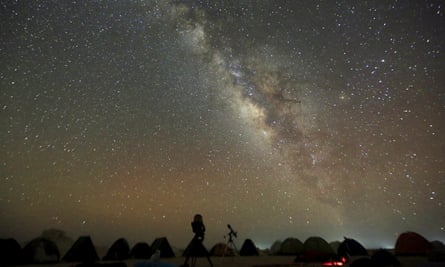“There is no light in earth or heaven / But the cold light of stars,” wrote the poet Henry Wadsworth Longfellow.
But for myriad writers and artists, that source of inspiration could be fading as research has revealed light pollution is rapidly reducing the number of stars visible to the naked eye. The study, published in the journal Science, suggests locations with 250 visible stars at present will have just 100 visible stars in 18 years.
“If these trends continue, eventually it will be very difficult to see anything at all in the sky, even the brightest constellations. Orion’s belt will start to disappear at some point,” said Dr Christopher Kyba, of the German Research Centre for Geoscience and first author of the research.
The team write that the glow produced by artificial lighting grew exponentially over the 20th century with population growth, new technologies, and expansion of towns and cities.
However the impact of a shift to light-emitting diodes (LEDs) in recent years is unclear. Satellites that can measure skyglow have limited resolution and cannot detect some wavelengths of light emitted by LEDs.
To delve deeper, the team analysed 51,351 citizen scientist observations of stars visible to the naked eye, made between 2011 and 2022 as part of a project called Globe at Night. Participants were asked to use a website to view a selection of star charts for their location – each showing an incrementally greater number of the stars that exist in that patch of sky – and pick the chart that best matched what they could see. The researchers then created a model that related the number of visible stars to the brightness of the night sky.
While the citizen science observations were rarely made multiple times in the exact same location, the researchers were able to group those with similar brightness of the night sky in a given year, and record the change over time.

The results reveal that on average across locations where participants made observations, sky brightness is increasing by 9.6% a year, with the figure slightly lower, at 6.5%, in Europe and slightly higher, at 10.4%, in North America.
after newsletter promotion
The study has limitations, including that observations were largely made in Europe and the US, and in inhabited areas. Kyba noted the night sky in developing countries may be brightening even more rapidly than the global average suggested by the new study because they are electrifying for the first time. But, he added, the more people take part in the citizen science project the better able the team will be to focus on different regions, or even individual cities.
The study is not the first to reveal the impact of light pollution on our ability to see the night sky. In 2016, scientists found the Milky Way was no longer visible to one-third of humanity.
Kyba said the results shine light on the money and energy wasted in night lighting, which also has environmental impacts.
Dr Greg Brown, planetarium astronomer with the Royal Observatory Greenwich, who was not involved with the work, said light pollution already limits astronomers’ ability to observe the night sky. “This study shows the stark reality of the problem and highlights how vulnerable unobstructed views of the cosmos really are in modern society,” he said.
Martin Rees, the astronomer royal, said preserving the night sky isn’t just an issue for astronomers. “The night sky is part of our natural environment – indeed a unique part, in that it has been shared by people all the world over, throughout human history,” he said.
Dr Constance Walker, another author of the study at the National Optical-Infrared Astronomy Research Laboratory in the US, agreed. “There is an irreplaceable awe that the natural night sky, a sky without any light pollution, provides. It inspires you and connects you to all of the wonders the cosmos holds,” she said.
“If that source of inspiration is diminished by washed-out, light-polluted skies, then we lose part of ourselves and what we can strive to be. It is part of our cultural heritage.”










